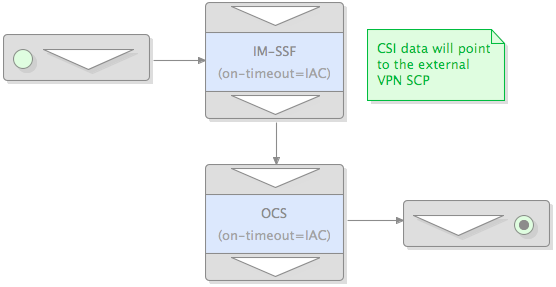The IM-SSF is a protocol translator that mediates between a SIP session with the SIS and a CAP or INAP session with an external SCP.
Below is an outline of how IM-SSF is triggered, looks up subscription information, classifies the call as originating or terminating, and runs the BCSM.
INVITE triggers a composition that invokes IM-SSF
The process starts when …
1 |
…the SIS receives an 
|
|---|---|
2 |
The SIS forwards the
|
3 |
IM-SSF uses a key to look up subscription information
To look up subscription information, IM-SSF first checks to see if the INVITE has an "IM-CSI-Key"header. If so, IM-SSF will use the value of theheader as the key to lookup subscription information. Otherwise, it will:
1 |
Get the destination MSISDN from the |
||
|---|---|---|---|
2 |
|||
3 |
If the call is originating:
|
||
4 |
If the call is terminating:
|
|
|
If IM-SSF fails to locate any subscription information for the call, it rejects the INVITE.
|
|
|
Getting an MSISDN from a SIP URI
If the IM-SSF cannot extract an MSISDN, it rejects the |
Classifying the call as originating or terminating
To classify a call as originating or terminating, the IM-SSF first checks to see if the INVITE includes an "IM-Access-Override" header. If the value of theheader is:
-
orig— IM-SSF applies originating treatment -
term— IM-SSF applies terminating treatment -
otherwise, the IM-SSF checks the parameters in the topmost Routeheader (see below).
|
|
The IM-SSF is configured with the parameter to look for (RqdParameter) and the expected parameter value (RqdParameterVal) that tells the IM-SSF if the call is originating access. RqdParameterVal may be empty, indicating that presence of the parameter is enough to classify the call as originating.{ocpanel}
|
|
|
You can define the parameter the IM-SSF looks for using the sis-console command configure-originating-access. See General IM-SSF Configuration for more details.
|
Inspecting the Routeheader
The IM-SSF inspects the topmost Routeheader and checks each parameter:
if (RqdParameterVal is Empty) then if (param == RqdParameter) then call is *originating*, else call is *terminating* else if (param == RqdParameter and paramVal == RqdParameterVal) then call is *originating* else call is *terminating*
In the following example, we can see an incoming INVITE that includes a parameter mode with expected value originating in the topmost route (in this case, the IM-SSF should be configured: configure-originating-access mode originating).
INVITE sip:1453800888888@ims1.operator.com SIP/2.0 To: <sip:1453800888888@ims1.operator.com;user=phone> From: <sip:+886230050000@ims1.operator.com;user=phone>;tag=snl_0008395652_NSN_CLIENT Call-ID: NSNSIP-c2421c0a-c4421c0a-1-11-1254881719-108155-1254989874 CSeq: 1235 INVITE ... Route: <sip:6N0j0Hg5C+O3p0hBLp~usAFA@172.28.81.7:5060;oc-node=101;lr;transport=udp;mode=originating>, ... ...
Running the BCSM
The IM-SSF executes the IM-BCSM following description 3gpp 23.278. An important aspect of this process is the subscription information it uses for the call. The subscription information tells the IM-SSF, among other things, the address of the external SCP to contact, the ServiceKey to use in the InitialDP message and how to respond in failure scenarios. The following tables explain the fields in both O-IM-CSI and VT-IM-CSI.
Properties common to both O-IM-CSI and VT-IM-CSI
| Field | Description |
|---|---|
Msisdn |
The unique id of the subscriber. This field is a string that is normally a digit sequence. It may, however, be a string that corresponds to the |
getGsmSCFAddress |
The SCCP address of the external SCF. |
ServiceKey. |
The service key to include in the |
DefaultCallHandling |
Indicates whether the IP multimedia session shall be released or continued in case of error in the IM-SSF to gsmSSF dialogue. One of ( |
CAMELCapabilityHandling |
Indicates the phase of CAMEL which is asked by the gsmSCF for the service. One of ( |
CSIActiveStatus |
Whether the CSI is active or not. |
TraceEnabled |
Whether detailed tracing should be done, if tracer level is |
O-IM-CSI
| Field | Description |
|---|---|
Trigger Detection Points |
|
CollectedInfo |
One of ( |
AnalyzedInformation |
One of ( Note that this TDP is only relevant for INAP. |
RouteSelectFailure |
One of ( |
VT-IM-CSI
| Field | Description |
|---|---|
Trigger Detection Points |
|
TerminatingAttemptAuthourised |
One of ( |
TBusy |
One of ( |
TNOAnswer |
One of ( |
|
|
See Configuring IM-SSF Subscription Information for the sis-console commands to use for managing the subscription information.
|
